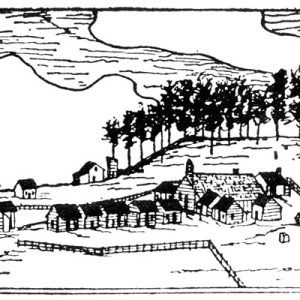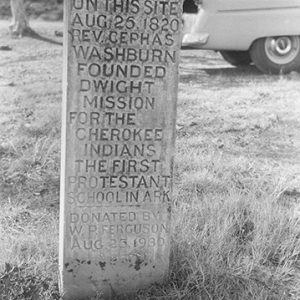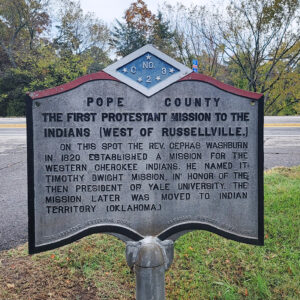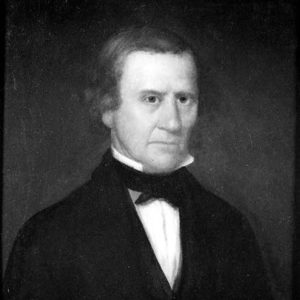calsfoundation@cals.org
Cephas Washburn (1793–1860)
Cephas Washburn was a Presbyterian missionary who helped found Dwight Mission to serve the Cherokee. Washburn, who struggled along with his colleagues to bring Christianity to Native Americans on the territorial Arkansas frontier, served as an educator and minister for four decades.
Cephas Washburn was born on July 25, 1793, in Randolph, Vermont, to Josiah Washburn and Phebe Cushman Washburn, who were farmers. Washburn turned from farming to education when he feared he might be disabled permanently from a broken leg. While teaching in Groton, Massachusetts, in the winter of 1814–1815 to raise money for further education, he became a Congregationalist and soon decided he wanted to be a missionary to the Indians. After graduating from Vermont University in 1817, he apprenticed in the ministry with Reverend Parsons of Pittsfield, Massachusetts. The Royalton Congregational Association in Randolph licensed Washburn to preach in January 1818.
On October 6, 1818, in Randolph, he married Abigail Woodward, his first cousin and the daughter of Asheal Woodward and Lucy Washburn Woodward. The Washburns had five children, the first three born at Dwight Mission and the last two born at New Dwight Mission, Oklahoma. One son, Edward Payson, was the famous painter of the “Arkansas Traveler.”
After he married, Washburn moved to Georgia, where he served with the Savannah Missionary Society to the Eastern Cherokee in 1818 and 1819. Washburn was given the Cherokee name Oo-kuh-squah-tuh while serving there. Because he apparently lacked confidence in his ability to speak the language, he used an interpreter for all his sermons and at least some of his interviews and visits with the Cherokee.
The American Board of Commissioners for Foreign Missions sent him with a party in late 1819 to establish what became the Old Dwight Mission for the Western Cherokee. As many as 4000 Cherokee had fled troubles in their eastern homeland and, helped by a treaty, were trying to establish a new homeland in Arkansas. Washburn, his wife, his brother-in-law Reverend Alfred Finney, and others sought to provide education and spiritual support to these Cherokee. Washburn served as superintendent there and later at the mission’s new location near Sallisaw, Oklahoma, after the Western Cherokee moved into Indian Territory in 1829. His wife was a tremendous help, sharing teaching and management duties.
Washburn’s account of the mission and the Arkansas Cherokee in his Reminiscences of the Indians, published posthumously in 1869, and in letters and reports to the American Board of Commissioners for Foreign Missions, provide important information on pioneer days in Arkansas. He was sympathetic to the Cherokee’s loss of native lands and was also interested in their traditions.
He continued as superintendent at New Dwight until 1840, when he retired from missionary service to raise and educate his children in a more settled environment. This decision may have been influenced by the disruption after 1835, caused by the forced removal of thousands of Eastern Cherokee to Oklahoma, and the subsequent removal of influence from the Western Cherokee with whom Washburn had spent two decades.
The Washburns moved to Arkansas. He preached for the next two decades from bases in Benton (Saline County), Fort Smith (Sebastian County), and Norristown (Pope County). Along the way, he established a short-lived integrated school for Indians and Euro-Americans and founded and pastored several churches. Eventually, he concentrated on evangelical preaching from Norristown.
Washburn died of pneumonia on March 17, 1860, in Little Rock (Pulaski County) while en route to an evangelical appearance at Helena (Phillips County). He was buried at Mount Holly Cemetery in Little Rock.
For additional information:
Coleman, Michael C. “Not Race but Grace: Presbyterian Missionaries and American Indians, 1837–1893.” Journal of American History 7 (June 1980): 41–60.
Jones, Dorsey D. “Cephas Washburn and His Work in Arkansas.” Arkansas Historical Quarterly 3 (Summer 1944): 125–136.
Ross, Margaret Smith, ed. “Three Letters of Cephas Washburn.” Arkansas Historical Quarterly 16 (Summer 1957): 174–192.
Shull, Laura L. “Washburn Family Returns.” Pope County Historical Association Quarterly 38 (September 2004): 46–50.
Washburn, Cephas. Reminiscences of the Indians. Conway, AR: Oldbuck Press, 1993.
Leslie C. Stewart-Abernathy
Arkansas Archeological Survey
 Dwight Mission
Dwight Mission  Dwight Mission Monument
Dwight Mission Monument  Washburn Home
Washburn Home  Washburn Memorial
Washburn Memorial  Cephas Washburn
Cephas Washburn 




Comments
No comments on this entry yet.